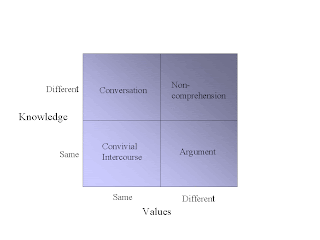Communication between and among people is very complex. There are many channels and nuances. However, for the purpose of innovation, I have found the following simple model useful. It is based on knowledge and values.
If people seeking to communicate have the same knowledge and the same values, communication is very easy. This is what happens between friends. It's comfortable. However, if you really have exactly the same knowledge and values, the transactions carry no real meaning. Nothing new can be created.
If the people have the same knowledge but different values, when communication is attempted, an argument usually results. Operating on the same knowledge with different values results in different interpretation and prioritization of the knowledge. This quite often happens in politics and religion. (And, it may be going on in America right now.)
If people have different knowledge and values, not much communication can take place. If an attempt at communication is made, a lack of understanding results, or at best a misunderstanding occurs.
If people have different knowledge but the same values, a conversation can result. In a conversation, innovation can occur.
The key strategy in any communication endeavor is to try to move toward a conversation. In the real world, the situation is not as black and white as I have depicted it. People almost always have some shared values or knowledge. The key to creating a conversation is to find some shared values and use these to build a conversation based on the different knowledge.
The more different the knowledge and values are, the higher the potential is for breakthrough innovations. The less different the knowledge and values are, the more likely incremental innovation will result.
For a copy of a presentation on these principles as well as MBTI in communication, click here.
Monday, December 6, 2004
Subscribe to:
Post Comments (Atom)


No comments:
Post a Comment